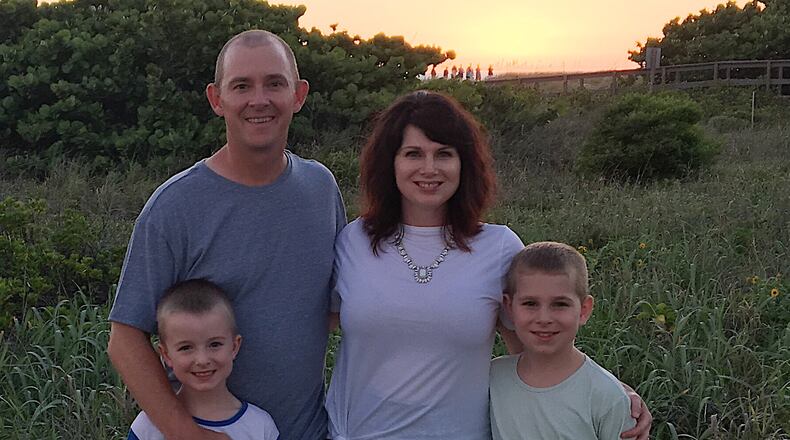Jackie Sapko and her husband spent the first five years of their son Colton’s life trying to keep him away from anything with peanuts.
Colton’s peanut allergy was so severe that even a tiny taste could send him to the emergency room. EpiPens, nut-free preschools and carting his own cupcakes to birthday parties became routine parts of life.
So when Sapko heard Children’s Mercy Hospital was offering an experimental treatment that would intentionally expose him to peanuts, albeit gradually, it was a tough call for her.
“That was something that my husband and I had to really talk about and pray about,” Sapko said. “We had to take a step back and say, ‘Is this really something we want to do with our son?’”
The Sapkos, took the leap and so far the results have been better than they hoped for.
Colton is now 6. His peanut sensitivity continues to decrease, and others are seeing the same effect in a clinical trial that could change the lives of thousands of people by reversing the rising tide of dangerous nut allergies in the U.S. and elsewhere.
Some allergy clinics in Kansas City and elsewhere have already been offering peanut desensitization treatments, but the study that Children’s Mercy is participating in is among the first worldwide to try it in a controlled, formal way.
Children’s Mercy allergist Jay Portnoy said the trial, which is going on at research sites across the country, has been so successful that as soon as the U.S. Food and Drug Administration approves a product for commercial use, the hospital will start offering it to pediatric patients who aren’t in the study.
The peanut treatment trial builds on previous research showing that after the American Academy of Pediatrics recommended delaying infants’ exposure to peanuts in 2000 in order to prevent allergies, the problem dramatically increased instead.
Portnoy said the decision wasn’t based on science.
“They just thought it sounded like a good idea and they admitted that,” Portnoy said.
The reported prevalence of peanut and tree nut allergies in U.S. kids tripled between 1997 and 2008 and hospitalizations for anaphylactic reactions climbed steadily.
The United Kingdom, also experienced increases after it enacted similar guidelines in 1998. Researchers there noticed something interesting: Jewish kids in the U.K. had much higher rates of peanut allergy than Jewish kids in Israel, even though their genetic heritage was similar.
After some study, they pinpointed the probable reason: One of the most popular snack foods for infants in Israel was Bamba, a peanut flavored puff.
After more research the U.K. and U.S. recommendations flipped: To prevent allergy, children should be gradually introduced to peanuts as infants.
A nonprofit called Food Allergy Research & Education then set out to find if a similar approach would work for treating kids who already had peanut allergies. Children’s Mercy, which is part of a network of 22 FARE clinical partners nationwide, was chosen as one of the sites to try it out.
That meant families like the Sapkos, who were already trekking to the hospital every few months for food allergy help, suddenly had a new treatment option.
By then, peanut and other food allergies had become a fact of life for Colton.
It started with reactions to egg and dairy and then, when he was 18 months old, he ate a bit of peanut butter and he broke out in hives.
Testing showed his peanut allergy was severe; potentially life-threatening.
Sapko and her husband got used to shielding Colton whenever they could. They didn’t let him sleep over at friends’ houses, they didn’t take him to restaurants and they didn’t fly on airplanes.
But there were still close calls.
“He has been in anaphylaxsis from peanut,” Sapko said. “He has had an EpiPen used on him, more than once.”
It was a constant, nagging stress for the family. And Sapko worried it would only get worse as Colton moved into school age, and she and her husband had less direct supervision over him.
If they joined the Children’s Mercy trial, Colton would be fed capsules with peanut powder in gradually increasing doses.
It would happen in a controlled environment, with medical professionals watching for any reaction. But it still made his mom uneasy.
Sapko said she talked to other parents who decided not to risk it.
“After a lot of prayer and talks with my husband, we kind of decided we didn’t have a choice,” Sapko said. “Because it scared me more to have him growing up in a world where he’s so sensitive.”
The treatments began under the watchful eye of Portnoy and the hospital staff, with EpiPens on hand.
Nothing went seriously wrong, for Colton or any of the other participants.
“Actually, we’ve not needed to use them,” Portnoy said. “The study’s done pretty cautiously and it seems to work pretty well.”
Colton has become markedly desensitized to peanuts.
In an oral test at the hospital last summer he was able to eat what Sapko called “a significant amount of peanut butter.”
“If he were to be accidentally exposed to it, he would probably be OK,” Sapko said.
The family now feels safe getting on a plane, Colton’s classmates can bring peanut snacks to school and Sapko can envision her son taking a girl out for dinner at a restaurant some day and maybe not even bringing an EpiPen.
He’s not cured, but he’s safe.
For Sapko, who had gotten used to just trying to get through each day without her son going into anaphylactic shock, that’s all she wanted. Helping other families is a bonus.
“We are making a better path for our kids,” Sapko said. “We talk about that with Colton. It’s hard for me to wrap my mind around it being something that’s going to be hopefully a step in the right direction for the whole allergy community.”
About the Author
Keep Reading
The Latest
Featured


